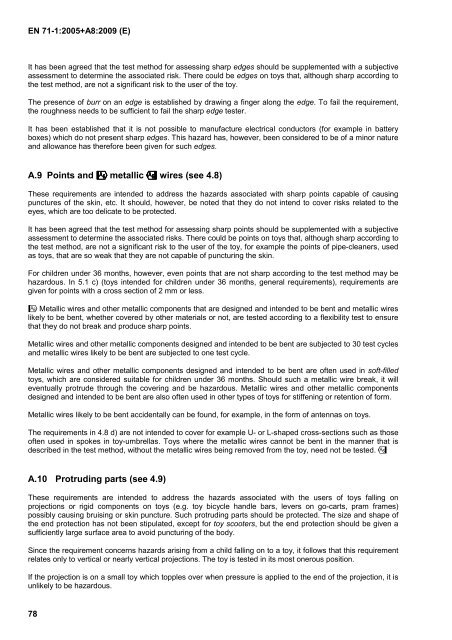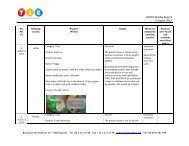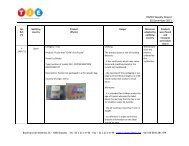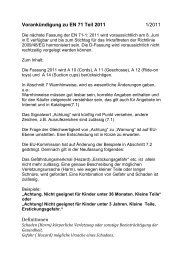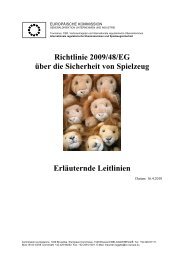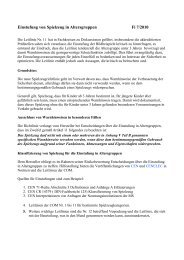You also want an ePaper? Increase the reach of your titles
YUMPU automatically turns print PDFs into web optimized ePapers that Google loves.
<strong>EN</strong> <strong>71</strong>-1:<strong>2005+</strong><strong>A8</strong>:2009 (E)<br />
It has been agreed that the test method for assessing sharp edges should be supplemented with a subjective<br />
assessment to determine the associated risk. There could be edges on toys that, although sharp according to<br />
the test method, are not a significant risk to the user of the toy.<br />
The presence of burr on an edge is established by drawing a finger along the edge. To fail the requirement,<br />
the roughness needs to be sufficient to fail the sharp edge tester.<br />
It has been established that it is not possible to manufacture electrical conductors (for example in battery<br />
boxes) which do not present sharp edges. This hazard has, however, been considered to be of a minor nature<br />
and allowance has therefore been given for such edges.<br />
A.9 Points and +metallic, wires (see 4.8)<br />
These requirements are intended to address the hazards associated with sharp points capable of causing<br />
punctures of the skin, etc. It should, however, be noted that they do not intend to cover risks related to the<br />
eyes, which are too delicate to be protected.<br />
It has been agreed that the test method for assessing sharp points should be supplemented with a subjective<br />
assessment to determine the associated risks. There could be points on toys that, although sharp according to<br />
the test method, are not a significant risk to the user of the toy, for example the points of pipe-cleaners, used<br />
as toys, that are so weak that they are not capable of puncturing the skin.<br />
For children under 36 months, however, even points that are not sharp according to the test method may be<br />
hazardous. In 5.1 c) (toys intended for children under 36 months, general requirements), requirements are<br />
given for points with a cross section of 2 mm or less.<br />
+Metallic wires and other metallic components that are designed and intended to be bent and metallic wires<br />
likely to be bent, whether covered by other materials or not, are tested according to a flexibility test to ensure<br />
that they do not break and produce sharp points.<br />
Metallic wires and other metallic components designed and intended to be bent are subjected to 30 test cycles<br />
and metallic wires likely to be bent are subjected to one test cycle.<br />
Metallic wires and other metallic components designed and intended to be bent are often used in soft-filled<br />
toys, which are considered suitable for children under 36 months. Should such a metallic wire break, it will<br />
eventually protrude through the covering and be hazardous. Metallic wires and other metallic components<br />
designed and intended to be bent are also often used in other types of toys for stiffening or retention of form.<br />
Metallic wires likely to be bent accidentally can be found, for example, in the form of antennas on toys.<br />
The requirements in 4.8 d) are not intended to cover for example U- or L-shaped cross-sections such as those<br />
often used in spokes in toy-umbrellas. Toys where the metallic wires cannot be bent in the manner that is<br />
described in the test method, without the metallic wires being removed from the toy, need not be tested.,<br />
A.10 Protruding parts (see 4.9)<br />
These requirements are intended to address the hazards associated with the users of toys falling on<br />
projections or rigid components on toys (e.g. toy bicycle handle bars, levers on go-carts, pram frames)<br />
possibly causing bruising or skin puncture. Such protruding parts should be protected. The size and shape of<br />
the end protection has not been stipulated, except for toy scooters, but the end protection should be given a<br />
sufficiently large surface area to avoid puncturing of the body.<br />
Since the requirement concerns hazards arising from a child falling on to a toy, it follows that this requirement<br />
relates only to vertical or nearly vertical projections. The toy is tested in its most onerous position.<br />
If the projection is on a small toy which topples over when pressure is applied to the end of the projection, it is<br />
unlikely to be hazardous.<br />
78


